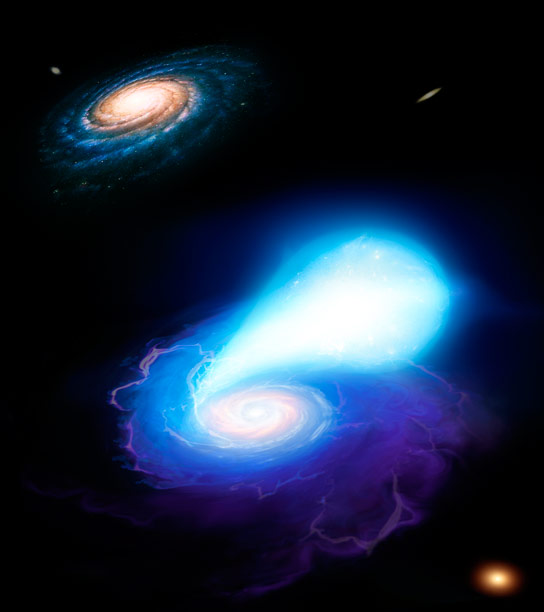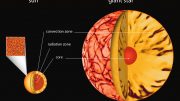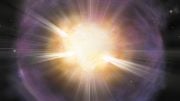
An artist’s impression of a neutron star and a white dwarf having been thrown far from their host galaxy. Once well outside the galaxy, they merge to produce the Universe’s loneliest supernovae. Credit: Mark A. Garlick / space-art.co.uk / University of Warwick
A new study from astrophysicists at the University of Warwick reveals that calcium-rich supernovae are likely created by white dwarf stars crashing into neutron stars.
A research team led by astronomers and astrophysicists at the University of Warwick has found that some of the Universe’s loneliest supernovae are likely created by the collisions of white dwarf stars into neutron stars.
Dr. Joseph Lyman from the University of Warwick is the lead researcher on the paper, The progenitors of calcium-rich transients are not formed in situ, to be published in the journal Monthly Notices of the Royal Astronomical Society.
“Our paper examines so-called `calcium-rich’ transients,” says Dr. Lyman. “These are luminous explosions that last on the timescales of weeks, however, they’re not as bright and don’t last as long as traditional supernovae, which makes them difficult to discover and study in detail.”
Previous studies had shown that calcium comprised up to half of the material thrown off in such explosions compared to only a tiny fraction in normal supernovae. This means that these curious events may actually be the dominant producers of calcium in our universe.
“One of the weirdest aspects is that they seem to explode in unusual places. For example, if you look at a galaxy, you expect any explosions to roughly be in line with the underlying light you see from that galaxy, since that is where the stars are” comments Dr. Lyman. “However, a large fraction of these are exploding at huge distances from their galaxies, where the number of stellar systems is minuscule.
“What we address in the paper is whether there are any systems underneath where these transients have exploded, for example, there could be very faint dwarf galaxies there, explaining the weird locations. We present observations, going just about as faint as you can go, to show there is in fact nothing at the location of these transients – so the question becomes, how did they get there?”
Calcium-rich transients observed to date can be seen tens of thousands of parsecs away from any potential host galaxy, with a third of these events at least 65 thousand light years from a potential host galaxy.
The researchers used the Very Large Telescope in Chile and Hubble Space Telescope observations of the nearest examples of these calcium-rich transients to attempt to detect anything left behind or in the surrounding area of the explosion.
The deep observations taken allowed them to rule out the presence of faint dwarf galaxies or globular star clusters at the locations of these nearest examples. Furthermore, an explanation for core-collapse supernovae, which calcium-rich transients resemble, although fainter, is the collapse of a massive star in a binary system where material is stripped from the massive star undergoing collapse. The researchers found no evidence for a surviving binary companion or other massive stars in the vicinity, allowing them to reject massive stars as the progenitors of calcium-rich transients.
Professor Andrew Levan from the University of Warwick’s Department of Physics and a researcher on the paper said:
“It was increasingly looking like hypervelocity massive stars could not explain the locations of these supernovae. They must be lower mass longer lived stars, but still in some sort of binary systems as there is no known way that a single low mass star can go supernova by itself, or create an event that would look like a supernova.”
The researchers then compared their data to what is known about short-duration gamma-ray bursts (SGRBs). These are also often seen to explode in remote locations with no coincident galaxy detected. SGRBs are understood to occur when two neutron stars collide, or when a neutron star merges with a black hole – this has been backed up by the detection of a ‘kilonova’ accompanying an SGRB thanks to work led by Professor Nial Tanvir, a collaborator on this study. Although neutron star and black hole mergers would not explain these brighter calcium-rich transients, the research team considered that if the collision was instead between a white dwarf star and a neutron star, it would fit their observations and analysis as it:
- Would provide enough energy to generate the luminosity of calcium-rich transients.
- The presence of a white dwarf would provide a mechanism to produce calcium-rich material.
- The presence of the Neutron star could explain why this binary star system was found so far from a host galaxy.
Dr. Lyman said:
“What we therefore propose is these are systems that have been ejected from their galaxy. A good candidate in this scenario is a white dwarf and a neutron star in a binary system. The neutron star is formed when a massive star goes supernova. The mechanism of the supernova explosion causes the neutron star to be `kicked’ to very high velocities (100s of km/s). This high-velocity system can then escape its galaxy, and if the binary system survives the kick, the white dwarf and neutron star will merge causing the explosive transient.”
The researchers note that such merging systems of white dwarfs and neutron stars are postulated to produce high-energy gamma-ray bursts, motivating further observations of any new examples of calcium-rich transients to confirm this. Additionally, such merging systems will contribute significant sources of gravitational waves, potentially detectable by upcoming experiments that will shed further light on the nature of these exotic systems.
R.P. Church and M.B. Davies of the Lund University Observatory, Department of Astronomy and Theoretical Physics, and N.R.Tanvir of the Department of Physics and Astronomy, University of Leicester made significant contributions to the work in addition to the University of Warwick researchers.
Reference: “The progenitors of calcium-rich transients are not formed in situ” by Joe Lyman, Andrew Levan, Ross Church, Melvyn Davies and Nial Tanvir, 9 September 2014, MNRAS.
DOI: 10.1093/mnras/stu1574
arXiv: 1408.1424









Be the first to comment on "Calcium-Rich Supernovae Formed by Colliding White Dwarfs and Neutron Stars"